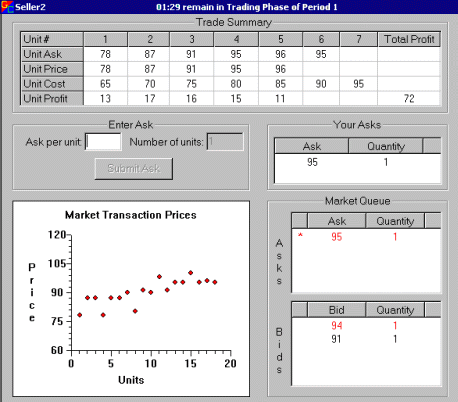|
|
|
Background
In one of the earliest market experiments, Chamberlin [1948] conducted
a classroom trading exercise that was designed as a test of the
competitive model. In Chamberlin's experiment, some students
were buyers who received a card with a unit value written on it,
and others were sellers who received a card with a unit cost
written on it. Students then walked about the room, and buyers and
sellers could negotiate over the terms of trade. When a deal was
struck, the price that the students agreed to was written on the
blackboard. This test produced trade volumes in excess of the
competitive equilibrium price, and trade prices that were quite
variable. It occurred to Vernon Smith, who had seen this classroom
exercise as a graduate student at Harvard in the early 1950's, that
this experiment could be redesigned with bidding rules similar to
those used in organized equity markets. In important experimental
tests, Smith [1962, 1964] centrally and publicly recorded all bids
and offers, instead of allowing traders to mingle in the room and
haggle over prices as in Chamberlin's experiment. This modification
to the trading rules, which is known as a double auction since both
buyers and sellers are active, leads quickly and accurately to the
predictions of the competitive market model.
As described by Smith [1982], these experiments provide an important
insights into the competitive model. Experiments using the double
auction institution converge reliably to the competitive price even
with as few as three or four sellers, and neither the buyers nor the
sellers need to have information about the values or costs of others
in the market. These experiments also demonstrate that price-taking
behavior is not a necessary assumption to reach the prediction of the
competitive model, since every seller actively chooses his asks and
which bids to accept, and every buyer chooses bids and which asks to
accept.
|
|
Operation
The double auction is a simple and very effective trading institution.
Figure 1 below shows a typical seller screen from a double auction
commodity market experiment. A buyer's screen for this experiment is
very similar.
|

|
|
Figure 1: Double auction seller's screen
|
|
In the double auction, any seller may submit an ask at any time during
a trading period. A typical double auction trading screen is shown
below. An ask is entered in the area labelled ``Enter Ask" on this
seller's screen display. This ask represents the seller's current
report of the lowest price that he is willing to accept for a unit
of some commodity or security. Similarly, buyers may submit a bid
at any time, which represents the buyer's current report of the
highest price that she is willing to pay for a unit of the commodity.
If an ask is placed that is at or below the current high bid, a trade
results. Similarly, if a bid is placed that meets or exceeds the
current low ask, a trade occurs. A seller may make any number of
asks and may trade any number of units, provided that he has the
units available to sell. Similarly, a buyer may make any number
of bids, and may trade any number of units provided that she has
the currency to complete the purchases.
|
|
Throughout each trading period, a queue on the screen of each seller
displays all current asks and bids (shown as the "Market Queue" in
figure 1; the screen of each buyer also displays both queues. When a
seller successfully enters an ask into the ask queue, his ask appears
in the "Unit Ask" row of the "Trade Summary" table, in the column that
corresponds to the unit the seller has offered for sale. Similarly, a
buyer sees an update to the appropriate cell in her Trade Summary table
when she enters a bid into the bid queue.
When a seller and buyer complete a trade, each one sees the "Unit
Price" recorded in their Trade Summary table, and the price is
included in a graphical display of all trade prices from the current
period, shown as the ``Market Transaction Prices'' graph. The length
of each trading period is known to each seller and to each buyer, and
a clock on the screen of each seller and buyer shows the time
remaining in the period.
|
|
The double auction example above includes several key elements, such
as entry of asks, the ask and bid queues, and a trade execution rule.
Many variants of the double auction have been used in experiments,
and also in equity markets such as NASDAQ. There is no single,
standard form for the double auction, but almost all variants share
a few characteristics. There are both ask prices and bid prices
submitted, trading takes places continuously over an interval of
time, and trades occur when a buyer's bid is at or above a seller's
ask, or a seller's ask is at or below a buyer's bid. Aside from
these few general characteristics, many specific rules have been
tried.
|
|
Double auction experiments
Double auction experiments are included in MarketLink for several
models, including a competitive market, a duopoly market, a monopoly
market, and an asset market. If you haven't yet used MarketLink to
run an experiment, go to the
MarketLink page for information. If you are familiar with
MarketLink, you can add these experiments to you profile from the
links below.
|
|
References
Chamberlin, Edward H. (1948). "An Experimental Imperfect Market," Journal
of Political Economy, 56:2, pp. 95-108.
Smith, Vernon L. (1962), "An Experimental Study of Competitive Market
Behavior," Journal of Political Economy, 70:2, pp. 111-137.
Smith, Vernon L. (1964), "Effect of Market Organization on Competitive
Equilibrium," Quarterly Journal of Economics, 78:2, pp. 181-201.
Smith, Vernon L. (1982). "Markets as Economizers of Information:
Experimental Examination of the 'Hayek Hypothesis'," Economic Inquiry,
20:2, pp. 165-79.
|
| |